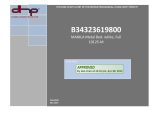
MN.51.V1.02 - VLT is a registered Danfoss trademark2
Centrifuges and other high inertia machines on VLT
®
5000 frequency converters
■■
■■
■ General
By use of VLT 5000 on centrifuges, separators,
decanters and other high inertia machines, VLT
default settings cannot be used.
Special care has to be taken because the load has
very high inertia. The following things have to be
considered:
1. Setting of minimum speed
2. Setting of ramps
3. Setting of slip compensation
4. Setting of torque limit
5. Limiting of maximum speed
6. Stopping
7. The behaviour by power sags
■■
■■
■ Setting of minimum speed
Use parameter 204 to limit minimum speed. Never
use parameter 201 (output frequency low limit). By
accelerating up to the minimum frequency the ramp
will only be stopped if the VLT touch alarm 12 or 13.
By accelerating up to minimum speed the output
frequency will be reduced if the VLT touch alarm 12 or
13. This will allow the VLT 5000 to absorb backlash in
the machine.
■
Setting of ramps
To get a soft and sensitive start, and in order to
prevent overshoot in speed, set the parameter 206
at S2.
■ Setting of slip compensation
To prevent speed hunting set parameter 115 at
0%. If the application demands the use of slip
compensation, set parameter 115 at 100% and
parameter 116 at 5s. The slip comp is a positive
feedback. Combined with high inertia the “slip
comp” has to be slow to prevent hunting and
instability.
■ Setting of torque limit
Especially in applications with separators, shock
load can occur. The VLT 5000 will then run in
torque limit. In VLT > 5062 parameter 221 has to
be set at 130%. This has to be done to prevent the
VLT to trip on alarm 13.
In some separators, backlash in the gearbox can
make noise. At high torque one can imagine that
the shafts get twisted by the torque. If the VLT is
brought into current limit it will limit the torque and
some of the tortion forces are released. That can
make noise. Using torque control can reduce the
problem.
■ Limiting of maximum speed
The maximum speed reference is set in parameter
205, and parameter 202 has to be adjusted 10%
higher in order to limit the maximum output speed.
This leaves room for the overvoltage control to
work. See also Stopping.
■ Stopping
An easy way to do it, is the use of “coasting”.
If the application does not allow the use of
“coasting”, but demands a ramp stop function, set
the “ramp down” time, when there are no brake
resistor connected, so high that the DC-bus voltage
is stable under deceleration. Remember to set
parameter 400 at overvoltage control and para-
meter 220 between 2-5%.
Some applications may get unstable at low speed,
especially in high horse power applications. The
function at stop feature can solve this problem. Set
parameter 123 at a frequency higher than the
unstable speed.
Please note that the braking time for VLT > 5062
must not be longer than 30 sec. (version 3.14x).
■ The behaviour by power sags
A restart of the VLT 5000 before the load is brought
to stand-still can be very stressing for the drive.
Using flying start (par 445) can prevent this stress.
Remember to set parameter 407 (Mains failure) on
Coasting.
If Kinetic back up or Controlled ramp down is
demanded, the load of the VLT must be less than
50 to 75% of nominal load. 50% is typical for VLT >
5062 (status software version 3.14x).
■ Beltdriven centrifuges
The belt in a beltdriven centrifuge isolates the rotor
in the motor from the machine ground. That can
cause voltage pitting damages in the bearings. This
problem can be eliminated by using 60
° AVM
modulation in parameter 446.







